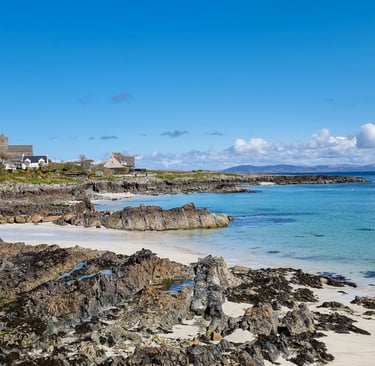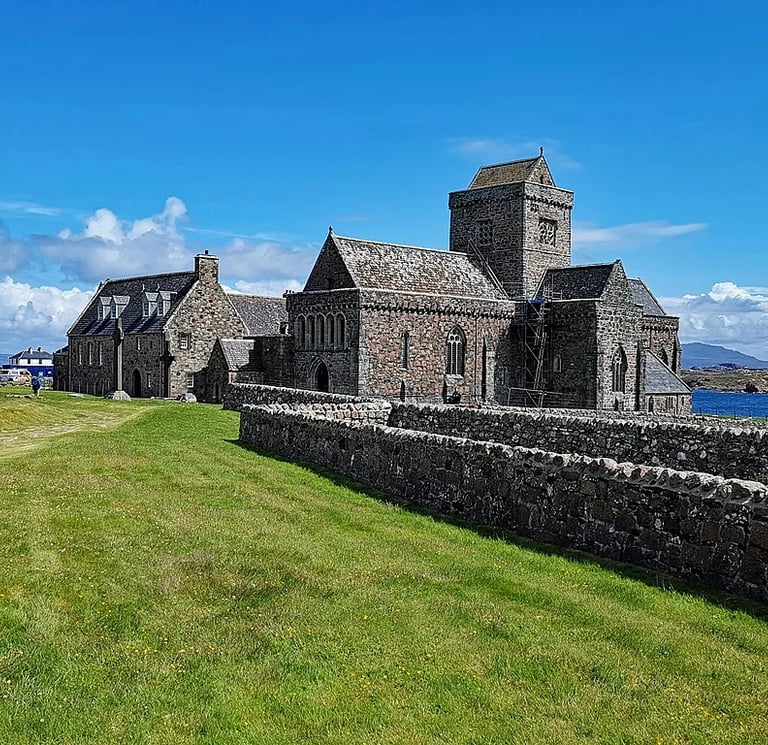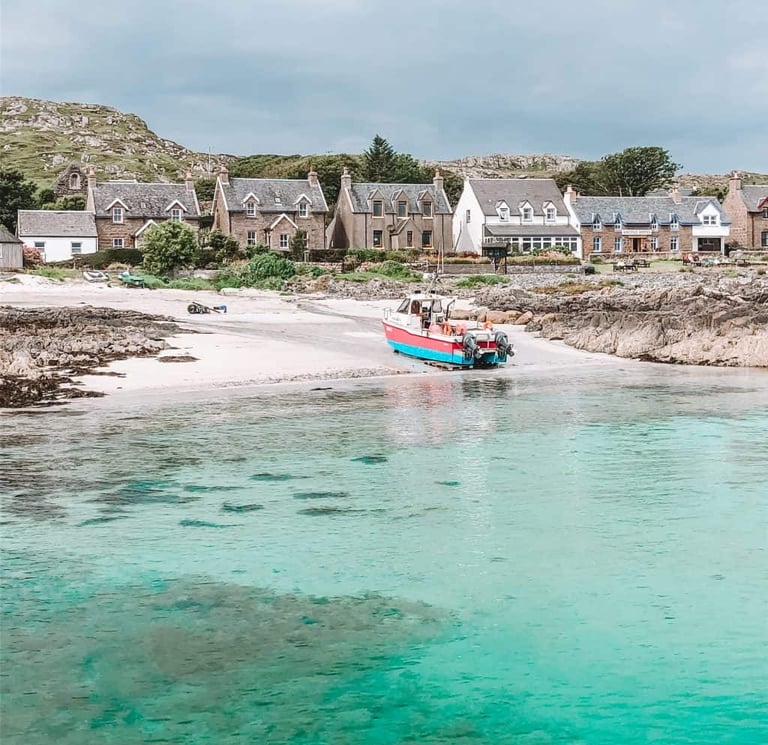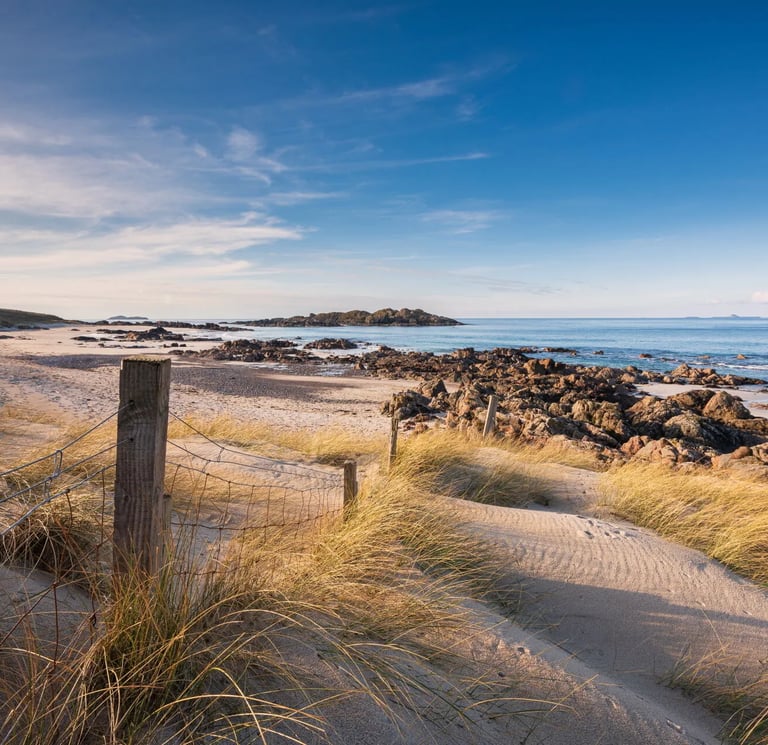Island of Iona and Abbey
PILGRIMAGE UK: HOLY PLACES


The island of Iona, a small and windswept jewel off the west coast of Scotland, holds a profound place in the spiritual and historical imagination of the Christian world. Known as the “cradle of Christianity” in Scotland, Iona has been a site of pilgrimage for over 1,400 years, drawing seekers of faith, solace, and inspiration to its shores. At the heart of this sacred isle stands Iona Abbey, a beacon of devotion and a testament to the enduring legacy of St Columba, who arrived here in AD 563 with twelve companions to establish a monastic community. Today, Iona remains a place where the veil between heaven and earth feels remarkably thin, offering pilgrims a unique opportunity to encounter the divine amidst the beauty of creation.
The journey to Iona itself is an act of pilgrimage. Accessible only by ferry, the island’s remoteness fosters a sense of anticipation and reflection. As the boat approaches the shore, the sight of the abbey rising against the backdrop of rolling hills and the vast expanse of the Atlantic Ocean evokes a sense of timelessness. The island’s rugged beauty, with its white sandy beaches, turquoise waters, and rocky outcrops, creates an atmosphere of peace and wonder—a fitting prelude to the spiritual journey that awaits.
Iona Abbey, restored in the 20th century, stands as a focal point of the island’s sacred heritage. Its stone walls, weathered by centuries of wind and rain, exude a quiet strength that speaks of the faith and resilience of those who built and sustained it. The abbey church, with its simple yet elegant architecture, invites pilgrims to pause and reflect on the mysteries of faith. The cloisters, with their intricate carvings and serene atmosphere, provide a space for contemplation and prayer. Walking through these hallowed halls, one cannot help but feel connected to the countless monks, pilgrims, and worshippers who have sought God’s presence here over the centuries.
The spiritual significance of Iona is deeply rooted in its history. St Columba’s arrival marked the beginning of a monastic tradition that would profoundly influence the spread of Christianity throughout Scotland and beyond. The monks of Iona were not only devoted to prayer and worship but also to the creation of illuminated manuscripts, such as the renowned Book of Kells, which is believed to have been started on the island. Their dedication to learning, artistry, and missionary work established Iona as a centre of spiritual and cultural life in the early medieval period.
As pilgrims explore the island, they encounter other sites that bear witness to its sacred past. St Oran’s Chapel, a small and ancient stone building, stands within the Reilig Odhráin graveyard, where many Scottish kings are said to be buried. This burial ground, steeped in legend and history, invites reflection on the transient nature of earthly power and the enduring hope of eternal life. Nearby, the remains of the Iona Nunnery, with its tranquil cloister garden, offer a glimpse into the lives of the women who dedicated themselves to prayer and service.
The natural beauty of Iona is inseparable from its spiritual allure. The island’s landscapes, shaped by wind and sea, inspire a sense of awe and reverence. Pilgrims often walk the island’s paths, tracing routes that lead to quiet coves, rugged cliffs, and panoramic views of the surrounding isles. These walks become acts of meditation, where the rhythm of footsteps mirrors the rhythm of prayer. The interplay of light and shadow on the land and sea serves as a reminder of the divine artistry present in creation.
For many, the pilgrimage to Iona is not only a journey to a sacred place but also an inward journey of renewal and transformation. The island’s tranquillity and isolation provide a space to step away from the distractions of daily life and to listen for the still, small voice of God. In the words of St Columba, “Delightful it is to stand on the peak of a rock, in the bosom of the isle, gazing on the face of the sea.” This sense of delight and wonder continues to draw pilgrims to Iona, where they find not only the beauty of the natural world but also the peace that comes from encountering the divine.
The legacy of Iona extends beyond its historical and spiritual significance. Today, the Iona Community, an ecumenical Christian organisation, continues the tradition of worship, hospitality, and social justice that has long been associated with the island. The community welcomes visitors from around the world, offering opportunities for prayer, reflection, and engagement with issues of faith and justice. This modern expression of Iona’s spiritual heritage ensures that the island remains a living centre of Christian witness and renewal.
In reflecting on Iona and its abbey, one is reminded of the enduring power of sacred places to inspire and transform. The island’s history, beauty, and spiritual atmosphere invite pilgrims to reconnect with their faith, to find solace in the rhythms of nature, and to draw strength from the example of those who have gone before. Whether standing in the abbey’s quiet cloisters, walking along the island’s windswept shores, or gazing out at the endless horizon, the pilgrim is reminded of the eternal truths of faith, hope, and love.
Iona is more than a destination; it is a sanctuary for the soul, a place where the sacred and the ordinary meet in a profound and transformative way. For those who journey to this holy isle, the experience is one of deep spiritual enrichment—a reminder that, in the words of St Augustine, “You have made us for yourself, O Lord, and our hearts are restless until they rest in you.” On Iona, amidst the beauty of creation and the echoes of centuries of prayer, the restless heart finds its home.
Iona: A Sacred Island of Pilgrimage, History, and Spiritual Renewal










Ancient Apostolic Catholic Church
Embracing faith, inclusion, and compassionate service together.
ST THOMAS AQUINAS SEMINARY
© 2025. All rights reserved
QUICK LINKS
